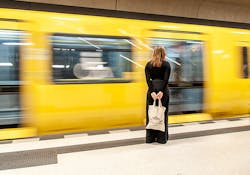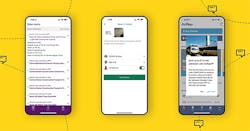This is a complicated question; however, the University of California in Berkeley conducted a study which showed that some of the factors are related to experiencing delays which they can attribute to the transit agency. The main areas of uncertainty are being delayed on board, experiencing long waits at the origin stop, missed trips due to wrong real-time information, overcrowding and long waits at a transfer stop.
There are ways that tech can help address these issues. However, despite the advances in tech solutions around public transit, not all potential and current transit riders can get the most out of these opportunities. In many instances, riders must download multiple apps to access all the information they need. And how will they know what apps are out there? If agencies want to offer all tech features on the market, this could mean that they procure and expect their riders to use up to seven separate apps. From an agency's point of view, this means the procurement, project management, marketing, and rider education for multiple apps, which is overwhelming for the agency.
Add into that the take up of some of these apps will be sparse due to lack of knowledge of their existence from riders it can add up to a big waste of money. The services would be underused and get lost in the noise.
What do these apps cover? All the tech solutions add up to offering the riders everything they need and go someway towards solving the problems we mentioned above.
A ticketing app, a trip planner, service disruption/rider alerts, safety and security, microtransit booking, customer engagement and feedback and real-time information. Whew, now that is a long list and if the apps are not connected a bit of a hassle for riders to check and consolidate everything to create a helpful picture of their journey.
No wonder many people feel that public transit is not serving them. This all sounds like a negative picture, but there is a way to fix this, which is far easier for both agencies and riders.
A modular solution offering all seven elements above in one agency-controlled app would hit the mark.
Unwire's mobility platform does just this. It has been developed from the start with this modular model in mind allowing the agencies to focus on providing their services and for riders to use them in the best way possible.
Unwire has worked with a large transit agency in the US to partner, in an open way, with other vendors, such as microtransit and micro-mobility, to bring their capabilities into one app. The biggest beneficiary of this is the rider.
"We see Unwire's willingness to work openly and cooperatively with other vendors as the most important reason for our success. For example, we work with Via, Spare and Rideco to offer microtransit to riders, with the Elerts See Say platform for security and safety integration,” explained Jesper Thor Rasmussen, Unwire CEO.
“Other vendors are now approaching us to integrate their services into our platform. This can only be good for both public transit and riders and agencies. As our platform has been developed as a modular system, like Lego, another Danish company, agencies can access all the building bricks they need to offer a comprehensive and rider focussed solution.”
Unwire's mobility platform enables seamless end-to-end journey experiences. From planning, booking and paying for multimodal journeys to communicating with the passenger, it removes barriers to mobility so that everyone can get on board.
The key features are
- Flexible ticketing, payment, and validation methodologies.
- Journey planning across mass transit, micromobility, microtransit, paratransit, rideshare and other multimodal options.
- Real-time rider information and trip planning.
- 2-way customer communication to serve and assist the riders where they are.
- Designed for easy integration to 3rd party services
There is one app for riders that services the whole region and brings all these services into the app. So the agency can concentrate on servicing and marketing one app to riders. The app can also evolve as the agencies wish, and they can add or remove services as needed.
A commuter's experience with a consolidated app
As I stepped out of my front door, I knew my commute to work would be a hassle. The traffic was always terrible, and finding a parking spot took a lot of work. I had considered taking public transit for a while but needed to figure out where to start. That was until I discovered a tech solution that could help me navigate public transit.
I downloaded a mobility app that showed me the nearest bus stop and the estimated arrival time of the bus. I could plan my route and transfer points, all from the comfort of my own home. The app even let me purchase my fare on my phone, eliminating the need to carry cash.
When I was on my way, there was a schedule change, but thanks to the rider alert on the app, I was made aware of this and could re-plan my journey with minimal disruption.
I thought I would have to walk the final stretch of my journey, but I could book a micro-mobility option through the app so I could get there faster.
Overall, my experience with public transit was much more manageable thanks to these tech solutions. Being able to plan, book and pay for my journey made it much easier than I thought. I no longer dread my commute and can even use the time to be productive. Giving public transit a try and utilizing these tech solutions has made my commute a breeze.





